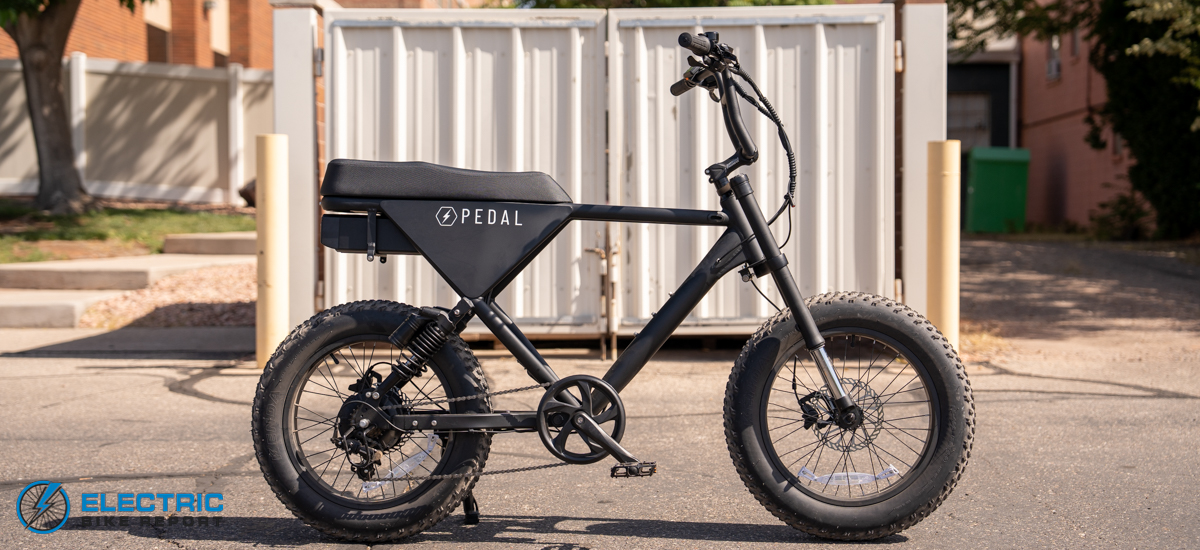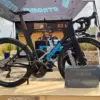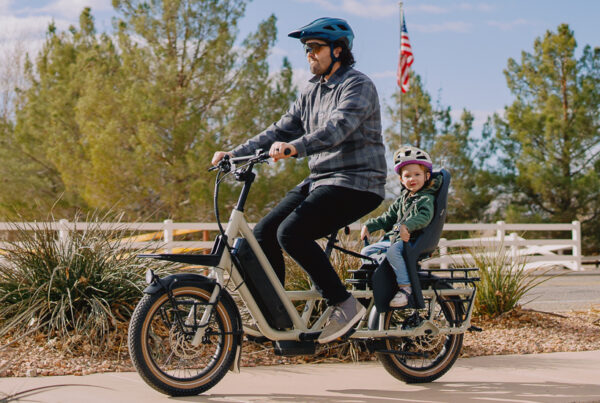Among the current tide of electric bikes lives the Pedal Core, a multi-purpose, moped-style fati tire e-bike suitable for cruising city streets during the week, and roving the outback wilds on the weekend. Sporting its motorcycle-famed inverted “upside down” forks, dual coil spring rear suspension, powerful 750-watt hub motor, and 20” x 4” knobby tires, the Core can take you to your favorite places, as well as places off the beaten path.
The suspension on this bike is not like other e-bikes, and it is refreshing to see this kind of ingenuity on a bike that’s priced below $2500. Both the fork and rear shocks are generic (no name brands), but feature the right design to optimize what the suspension can handle and do for you. The inverted, upside down fork has better rigidity and strength for repeated bumps and dropoffs. The dual rear shocks, with their coil spring and piggyback reservoirs are built to handle the 400 lbs weight capacity this bike can take, while also minimizing possible shock fade when tackling long downhills and whoop-dee-doos.
Mounted at the top of the rear shock is the “piggyback reservoir” holding most of your hydraulic fluid. It prevents the internal hydraulics from overheating and losing its viscosity when working to cushion against bumps. Piggybacks cost more than non-piggyback shocks, and require more maintenance. Piggybacks also weigh around 2.5 lbs more than non-piggybacks, but if you have experienced shock fade on rides, then you will embrace having the piggyback reservoir keeping your hydraulic fluid separate from the compression chamber so it doesn’t heat up and lose viscosity.
If you’re unfamiliar with shock fade, that’s when the shock faces an excessive amount of compression and rebound during your ride, and the shock begins to lose its effectiveness in responding to terrain changes.
Another benefit with this shock is that it uses a heavy duty coil spring to withstand bounces. It’s easier to fine tune the sag and rebound on the coil than air shocks – you only need a $10 spanner wrench to turn the locking nut. The shock design is excellent for this type of bike for a couple of reasons. This first is the heavy duty coil spring. It handles weight changes better than a lighter weight air shock, meaning the changes from adding and dropping off a passenger don’t require adjustments on the shock.
The piggyback reservoir is ideal because it provides a place to separately store suspension fluid for when the shock heats up. When you ride more actively over bumps, the shock heats up and the suspension fluid decreases in viscosity from the heat. This causes the shock to lose its effectiveness in compressing and rebounding. With cooler suspension fluid coming from the piggyback reservoir, your shock is more likely to work the way it’s meant to.
The rocket-like speed this bike produces comes courtesy of the “Bah-fung” 750W rear hub motor. Tethered by its right hand half-grip throttle, that propels it up to 20 mph fairly quickly, the pedal assist system is adjustable so that you can make this a Class 2 e-bike that maxes out at 20 mph, Class 3 at 28 mph, or at the Sport Mode max of 32 mph. You’ll want to make sure your PAS setting is in compliance with local e-bike laws, depending on where you’re riding.
Tucked away beneath the long saddle is the 15 Ah battery that gives the motor the juice it needs. The battery charge port is easily accessible at the bottom rear, or you can easily slide the battery out for charging and security. There is also an on & off button at the rear that you’ll need to press before turning on the PAS display to ride. In a couple of minutes I will go over the range test details, but for now I’ll just say that we were pretty happy with how much distance this battery gave us.
Controlling the speed levels that govern the motor is a pedal assist system (PAS) that has 5 levels and is activated by the plus and minus buttons on the left hand side of the display screen. There’s nothing fancy about this system, but it was reliable and easy to use in dispersing the speed options we selected when riding.
The brakes on this bike have the Pedal logo on it, meaning we’ve never seen the before since this is the first Pedal electric bike we are testing. Sneak peak, these brakes did great on our brake test. But in the meantime, I’ll just mention that they are hydraulic disc brakes, with 180mm rotors and dual piston calipers.
Gearing is provided by a simple Shimano 3-speed concoction that we haven’t seen before. The folks at Pedal said they chose this for simplicity. The 17-23T cassette wasn’t something we’d choose for this bike, given the ghost pedaling issue we experienced when topping out at 20 mph. But given the zippy acceleration we got from the throttle and PAS, we didn’t need to dwell on that very often.
Accessing the pedal assist and tracking your ride details is the color LCD display screen. It is pretty basic, displaying your current speed, PAS level (in red), total and trip miles, battery life (in green), and has a simple on and off button on the underside, a mode button on the left side, and up and down buttons for adjusting your PAS level. This stand alone unit works just fine. A lot of companies are coming out with companion apps which Pedal doesn’t have at present, but might be something they could look to in the future for enhanced metrics and ride customization for those who want it..
One of the great features that give this bike the sporty riding style and cool look is the BMX-style handlebar. With it’s 10.5 inch rise, these bars not only give you a comfortable riding posture, but they also give you a sense of full control of your bike, no matter what you’re riding over. The rubber grips worked great for keeping control, although more sporty riders might want to go for a nice pair of after-market rubber ergonomic grips to get more out of their ride.
The rapid fire trigger shifter worked great when we needed to make that occasional gear change, and levers and display were positioned in easy-to-operate fashion, allowing us to focus on our ride.
The cushy long saddle, easy pedaling, and grabable grips and levers, combined with the swift power, smooth suspension and fat tire trekking made for a comfortable and enjoyable ride on the Pedal Core.
So those are the key specs on this bike. It all sounds great but how did this bike really do in our performance tests? Well, that’s coming up next.
Source link








